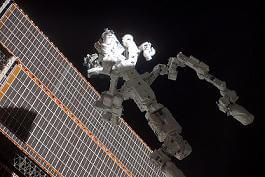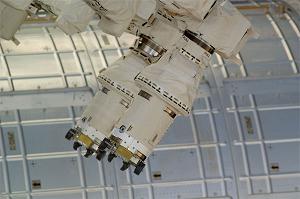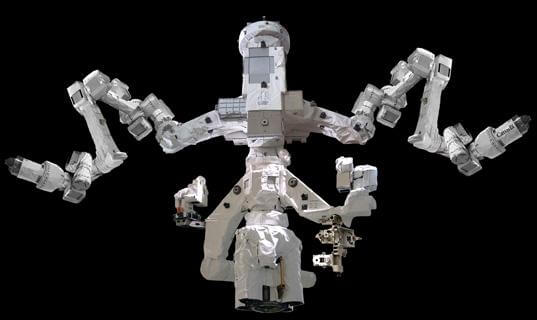Dextre Robot On Space Station Almost Ready For Duty

Share
"The most sophisticated robot every built...is a handyman." ---Canadian Space Agency
After more than two years, the International Space Station is very close to bringing its Dextre robot completely online. Built by Canada, Dextre is a large white robot with two highly articulated arms, and is meant to assist with repairs aboard the station, reducing the need for astronauts to take EVAs (space-walks). It's a prime example of how robots can take over tasks that are too dangerous for humans, especially in extremely harsh environments like space. Despite Dextre's potential, however, it has faced a series of setbacks since it first arrived at the ISS. Which means it's also a prime example of how robotics has yet to meet our increasingly high expectations.
Space missions have often been the proving ground for some of the most advanced and reliable robotics. While there have been automated systems on every craft since the beginning of space flight, more recent robots like the MARS Sojourner rover have highlighted the capabilities of autonomous exploration. But with these successes come high expectations of what future robots will be capable of. While robots may one day meet and exceed these expectations, it's important to realize that in the near term, many robotic systems are solutions first, grand goals for humanity second.
At its core, Dextre is a repair robot. It is designed to replace the need for humans in a variety of repairs on the ISS, freeing astronauts to perform the scientific experiments that are the reason for them living in space. It also cuts down on risk, by removing the need for humans to take space walks to make minor repairs.
The ISS is an extremely complex and fragile system, and so its handyman must be both complex and precise. Each of Dextre's arms has seven joints, each with three degrees of freedom. Its grasping hand comes complete with cameras and complex sensors so that it can delicately handle ISS parts without breaking them. The CSA says it has a 'human-touch'. Dextre has a toolkit with three different tools to use in repairs, and its hands have socket drives. The hands can also provide power and sensor hookup to external instruments in case its need to repair delicate electronics. While it was designed to be operated from the ISS, it has been adapted to be tele-operated directly from Mission Control on Earth. Dextre follows commands but can handle components of its tasks autonomously. It has precision down to a few millimeters, and can even attach to an elongated arm (Canadarm2) to reach areas all around the ISS. With all of these capabilities, and its durability to handle a space environment, it's no wonder Dextre is sometimes referred to as the most advanced robot anywhere on or above the world.
Be Part of the Future
Sign up to receive top stories about groundbreaking technologies and visionary thinkers from SingularityHub.


Yet from the beginning, Dextre had its setbacks. It had problems with its heaters, which was eventually tracked down to a bad cable. There were troubles with one of the arms, a shoulder roll joint was acting up. A power switching unit had errors.
But by early 2010, Dextre seemed like it resolved all of its issues. July 20th was supposed to be one of the final tests of its capabilities: removing and replacing a failed breaker box (RPCM). During a dress rehearsal, however, the RPCM got stuck and couldn't be removed. It seems that the pulling force of the robot during the operation was underestimated, and this was likely responsible for jamming the RPCM in place. It should take a few days before the robot is ready to attempt its final exam again.
I don't want to disparage Dextre. Far from it. It has the potential to be a very successful robot that saves astronauts time and lives. But I do think it also serves as a reality check for many of us interested in the development of robotics. These machines can accomplish extraordinary things (get launched into deep space, explore the surface of MARS, conquer factories, etc) but they also require years of fine-tuning and dedicated trouble shooting to work correctly. As we discuss the creation of humanoid robots, household robots, and robotic cars we should keep in mind the lessons from robots in space: it's going to take a lot of time and effort before they're ready.
[image credits: NASA via Wikicommons]
[source: CSA, NASA Space Flight]
Related Articles

These Robots Are the Size of Single Cells and Cost Just a Penny Apiece

Scientists Say We Need a Circular Space Economy to Avoid Trashing Orbit

In Wild Experiment, Surgeon Uses Robot to Remove Blood Clot in Brain 4,000 Miles Away
What we’re reading


